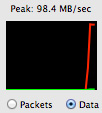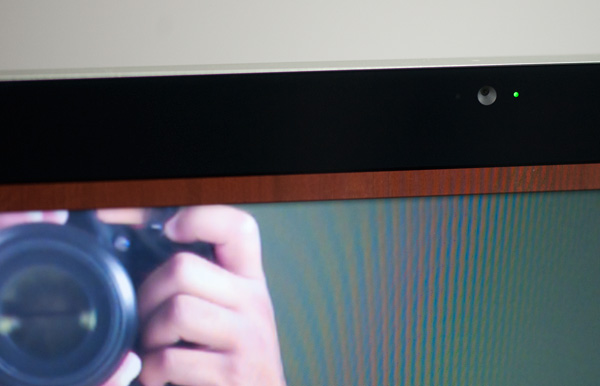The Apple Thunderbolt Display Review
by Anand Lal Shimpi on September 23, 2011 2:56 AM EST- Posted in
- Displays
- Mac
- Apple
- Thunderbolt
- Thunderbolt Display
Testing the Pieces
Before we get to the display and Thunderbolt specific testing I wanted to confirm that the individual controllers in the Thunderbolt Display were just as capable as those in the Mac it was connected to. For the most part, they are.
Following in Brian Klug's footsteps, I created two RAM disks - one on a MacBook Air and one on a MacBook Pro. I connected both systems to my local GigE network and copied giant files between them. I measured over 780Mbps going from the MacBook Air to the MacBook Pro, and 832Mbps in the other direction (images below). That's about as good as it's going to get.
 |
 |
Next I tested performance over FireWire 800 and USB 2.0. For FireWire 800 I used a Western Digital My Book Studio Edition II configured in RAID-1 and measured peak read speed from the device. For USB testing I turned to a Corsair Flash Voyager 3.0 (USB stick) and a SF-2281 SSD connected to a SATA-to-USB bridge. In both of the USB tests I measured write speed to the USB 2.0 devices. Apple appears to have chosen its FireWire controller well as performance was only off by 2MB/s compared to the FW800 port on the 15-inch MacBook Pro. USB 2.0 performance wasn't nearly as good however, I maxed out at 16.4MB/s and saw typical rates closer to 15MB/s:
| Transfer Rate Comparison | |||||
| FireWire 800 | USB 2.0 (stick) | USB 2.0 (SSD) | |||
| Apple Thunderbolt Display | 70.0 MB/s | 14.1 MB/s | 16.4 MB/s | ||
| Apple 15-inch MacBook Pro (2011) | 72.0 MB/s | 21.2 MB/s | 32.2 MB/s | ||
Both the audio controller and FaceTime HD cameras interface via the Thunderbolt Display's internal USB controller. It's likely that one of those devices is forcing the controller to negotiate at a lower speed and thus ultimately limit peak USB 2.0 performance through the display. Note the gap in performance is much smaller if you're looking at transfers to a USB stick vs. an SSD. I happen to have a lot of SSDs around so I tend to use them as glorified USB sticks, I suspect the majority of users won't notice much of a difference due to the lower overall performance of standard USB sticks.
FaceTime HD Camera
Although Photo Booth in Lion captures at 1080 x 720, using iSightcapture I was able to confirm that the sensor in the Thunderbolt Display appears to be able to capture 1280 x 720 natively. Quality is what we'd come to expect from the current generation of FaceTime HD cameras.
I tested the camera both in Photo Booth and in a FaceTime chat with our own Brian Klug. The experience worked fine in both cases.

FaceTime seems to have issues when one party is in a noisy environment but that doesn't appear to have anything to do with the Thunderbolt Display hardware as I duplicated the issue on a MacBook Air as well. If you're curious, the problem I'm talking about occurs when the party in a quiet environment is trying to talk to the person with a lot of background noise. The quiet party will hear audio just fine but the noisy party will get a lot of broken up audio from the other side. It seems like FaceTime is trying to do some active noise cancelation that ends up doing more harm than good. I confirmed it's a FaceTime software problem by calling Brian via Skype without any issues.











275 Comments
View All Comments
Ryan Smith - Friday, September 23, 2011 - link
We replaced the video a couple of hours ago with one that has better audio. You shouldn't be seeing any links to the old one (and if you are, please say where).KPOM - Friday, September 23, 2011 - link
Are there any technical reasons for using Eagle Ridge in the Thunderbolt Display instead of Light Ridge, or is it just Apple being Apple? Had they used the latter, it would have been possible to daisy chain a Cinema Display directly to the Thunderbolt Display, right?Also, on page 8, there is a slight error. You say "The MacBook Air is a different story. Not only does it only support two displays, but the Light Ridge controller only has a single DisplayPort input so you're not driving more than one external display via a MBA no matter what you do."
I think you meant to say "Eagle Ridge" controller.
-=Hulk=- - Friday, September 23, 2011 - link
Why does Intel doesn't use the daisy chaining feature of DisplayPort 1.2 instead of encapsulating individual DP v1.1 streams???Ryan Smith - Friday, September 23, 2011 - link
If I had to go out on a limb, a single TB channel doesn't have enough bandwidth for DP 1.2.Trefugl - Friday, September 23, 2011 - link
I really really love the features that thunderbolt adds to the MBAs (e.g. FireWire and GigE), but I don't want to have to upgrade my entire monitor every time I want to upgrade to the next hub (for maybe USB3 support, or more ports, etc). This would only get worse if they started to put GPUs into the monitor, as GPU tech becomes significantly outdated every year or two, whereas a good monitor can last you 5+ years. Why can't they just release a sleek HUB that you can have sitting behind your monitor. Their approach just doesn't make sense if you already have a 27" or 30" monitor (nor for future upgrades).slashbinslashbash - Friday, September 23, 2011 - link
If you already have a 27" or 30" monitor, then yes, this doesn't make as much sense. If you are just now buying such a monitor, then the Thunderbolt Display makes perfect sense. There is nothing keeping you from buying a future box/hub that you describe, and using it between the MBA/MBP and the display (if the box/hub has a built-in GPU) or daisy-chaining it after the display (if you just want USB3 or other ports). That's the great thing about Thunderbolt, you can keep adding on to it. This display is not necessarily the final link in the chain, nor is it necessarily the first link in the chain. It provides useful functionality at a competitive price today, and the add-on capabilities of Thunderbolt will continue to be useful as new tech comes on line.Trefugl - Friday, September 23, 2011 - link
But what happens when the "next cool thing" comes out that we want in our monitors? Do you just replace a perfectly good monitor because you want to upgrade the addons? I suppose my feelings towards this stem more from the iMac, where you trash a good monitor every few years because you want a new all in one PC...slashbinslashbash - Friday, September 23, 2011 - link
Nobody trashes their old iMacs. The secondary market for Macs is huge. It's not like the PC world where your 3-year-old CPU and mobo would go for $100 so you just keep them as backup or put them into a machine for folding or something. With iMacs, if you upgrade at 3 years then you can probably still get around 40-50% of what you paid for it. 2008 iMacs are regularly going for $600+ on eBay. You buy a new one, transfer everything over, and sell the old one. It's almost like buying a car where you 'trade in' your old model.HMTK - Friday, September 23, 2011 - link
This must be a US phenomenon then.jecs - Friday, September 23, 2011 - link
Well, not a US exclusive or phenomenon.It happens worlwide because most Mac laptops or Pro Macs have been traditionally decent machines (not the best or the most specialized but sure not the cheapest). Some people like OSX but doesn't want to expend on new hardware.
And not a phenomenon because this is not exclusive to Macs but to many decent products that age well including speakers, cars, movies or albums and many more things.